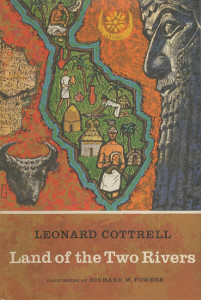Land of the Two Rivers

Author:
Leonard Cottrell
Illustrator:
Richard M. Powers
Publication:
1962 by The World Publishing Company
Genre:
History, Non-fiction, World Cultures
Series:
Major Cultures of the World ![]() Members Only
Members Only
Current state:
Basic information has been added for this book.
It has been read but content considerations may not be complete.
Book Guide
Search for this book used on:
A traveler crossing the flat alluvial plain between the Tigris and Euphrates rivers in present-day Iraq would find it hard to believe on the evidence of his eyes alone that here (and in one other land: Egypt) human beings first learned to live a civilized life. Yet about five thousand years ago—when most other men were still Stone Age hunters and wanderers—this hot, desolate land was covered with green fields of wheat and barely threaded by canals, all belonging to the temple whose ziggurat towered there against the sky. And inside the walled cities on the banks of the broad rivers crowded with ships were mud-brick houses lining streets radiating form the massive temple-sanctuary and the resplendent palace of the king.
A few thousand years before, these people too had been wanderers and hunters, but gradually they had become settled farmers on the rich soil of the plains. And then, suddenly, in only about 1,500 years—a matter of only four minutes if one reckons man's half-million-year history in terms of twenty-four hours—civilization as we know it, "exploded."
The plain of Shinar; Ur, the birthplace of Abraham, the tower of Babel; Babylon; Nineveh (woe to the bloody city!); Sennacherib, Nebuchadnezzar, and Belshazzar, all these are famous in Biblical story. But it is only during modern times that, due to the work of dedicated archaeologists, we have learned the real history of the people who built, destroyed, lived, and died in the Land of the Two Rivers.
Mr. Cottrell's richly detailed rec-creation of the civilizations of Sumer, Babylon, and Assyria is handsomely illustrated by Richard M. Powers.
From the dust jacket
To view an example page please sign in.
Find This Book
Search for this book used on:


